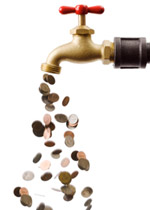 We stumbled upon an interesting statistic the other day: According to DomainTools there are more than 380 million deleted gTLD domain names, i.e. domain names that at some point have been registered but no longer exist. More than 80% of those are .com domain names.
We stumbled upon an interesting statistic the other day: According to DomainTools there are more than 380 million deleted gTLD domain names, i.e. domain names that at some point have been registered but no longer exist. More than 80% of those are .com domain names.
This number needs to be put into perspective to understand how unnaturally large it is. The total number of active gTLD domain names (.com, .net, .org, etc.) today is about 118 million. We find it hard to believe that on top of these, there would have at some time existed another 380 million legitimate domain names.
So how did that number become so large? The answer is quite simple: domain tasting.
Domain tasting, big business
Domain tasting, if you have not heard about it, was a practice that abused a loophole in domain name registration rules that made it possible for registrants to get a full refund if a domain name was deleted within five days of its creation, something called the Add Grace Period. This allowed domain names to be “tasted” for free for five days, directing them to pages serving ads.
Being a high-volume business, millions and millions of domain names were registered and deleted this way every month.
We’re using past tense here because thanks to two recent regulatory changes by ICANN, domain tasting was effectively killed off by mid 2009. The Add Grace Period still exists, but it is no longer possible to get all your money back, which has removed the profit margin for those who used this practice.
How big was domain tasting?
Domain tasting has been killed off, but when it was active it had a huge effect on the domain registration system. Until the first measure to minimize domain tasting was put in effect (in April 2008), domain tasting had run rampant for several years, especially on the .com domain which is the one that suffered the most.
And since domain tasting was a volume business and didn’t cost anything, the volumes involved were staggering. At its worst, more than 15 million domain names were “tasted” in just one month on just the .com domain. Close to 18 million if you count all top domains.
How big was domain tasting compared to legitimate domain name registrations?
- In April 2006, only 2 out of every 35 registrations were permanent (i.e. legitimate). That’s less than 6% legitimate registrations. The rest was domain tasting.
- In early 2007, according to GoDaddy only 3.6 million out of 55.1 million registrations were permanent, the rest were dropped at the end of the five-day add grace period. That also puts the amount of legitimate registrations around the 6% mark.
That means that domain tasting accounted for roughly 94% of domain name registrations during this period.
Considering such a vast majority of domain name registrations were the result of domain tasting, we can assume that a similar ratio is true for that huge volume of 380 million once-active domain names.
The giant footprint left by domain tasting
It’s not a perfect correlation, but we would not be surprised to see that close to 94% of those 380 million deleted domain names were the result of domain tasting. However, let’s be generous and assume that “only” around 90% were the result of domain tasting. After all, over time, a portion of the active domain names will not be renewed and thus deleted, so a good deal of legitimate deletions will have happened as well.
That estimate puts the “legacy” of domain tasting to around 340 million deleted domain names. This is a bit abstract in the sense that these domain names no longer actually exist, but it’s a measure of the enormous abuse of the domain name registration system that was going on.
And there’s one more thing we haven’t mentioned so far: Those are just the domain names that weren’t kept by the domain tasters. If domain tasters stumbled upon domain names that would be profitable long term (profitable meaning that the ad clicks were more than the yearly fee for a domain name), they kept them. How many of today’s active domain names these account for, no one knows.
Data sources: ICANN (PDF about the death of domain tasting), Wikipedia, DomainTools.


























